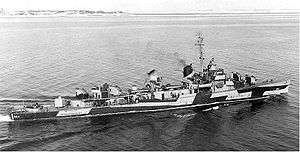USS Richard P. Leary
 | |
| History | |
|---|---|
| Name: | USS Richard P. Leary |
| Namesake: | Richard P. Leary |
| Builder: | Boston Navy Yard |
| Laid down: | 4 July 1943 |
| Launched: | 6 October 1943 |
| Commissioned: | 23 February 1944 |
| Decommissioned: | 10 December 1946 |
| Struck: | 18 March 1974 |
| Fate: |
|
| Name: | Yūgure |
| Acquired: | 10 March 1959 |
| Struck: | 1974 |
| Fate: | Returned to US, 10 March 1974 |
| General characteristics | |
| Class and type: | Fletcher-class destroyer |
| Displacement: | 2,050 long tons (2,083 t) |
| Length: | 376 ft 5 in (114.73 m) |
| Beam: | 39 ft 7 in (12.07 m) |
| Draft: | 13 ft 9 in (4.19 m) |
| Propulsion: |
|
| Speed: | 35 knots (40 mph; 65 km/h) |
| Range: | 6,500 nmi (12,000 km) at 15 kn (17 mph; 28 km/h) |
| Complement: | 329 |
| Armament: |
|
| Service record | |
| Part of: |
|
| Operations: |
|
| Awards: | 6 battle stars |
USS Richard P. Leary (DD-664) was a Fletcher-class destroyer of the United States Navy, named for Rear Admiral Richard P. Leary (1842–1901). In 1959, the ship was transferred to the Japanese Maritime Self-Defense Force and renamed Yūgure. The destroyer remained in service with the Japanese until 1974, when she was returned to the US, who then sold the ship for scrap in 1976.
Construction and career
Richard P. Leary was laid down on 4 July 1943 at the Boston Navy Yard, Boston, Massachusetts; launched 6 October 1943, sponsored by Mrs. George K. Crozer III; and commissioned 23 February 1944, Commander Frederic S. Habecker in command.
World War II
Following shakedown off Bermuda, Richard P. Leary sailed via the Panama Canal for Pearl Harbor. After escort duty to Eniwetok and Saipan in July, she supported the landings at Peleliu 15 September 1944, and at Leyte 20 October. During the Battle of Surigao Strait on 25 October, she launched torpedoes at the Japanese battleship Yamashiro, splashed one enemy plane, and guarded the damaged destroyer USS Albert W. Grant. While patrolling off Leyte Gulf on 1 November, she rescued 70 survivors of the destroyer USS Abner Read.
During the Lingayen Gulf campaign, Richard P. Leary on 6 January, during a suicide attack, she severely damaged an incoming Nakajima J1N "Irving" fighter, which managed to graze the forward 5-inch gun mounts before crashing—the only damage of the war. Later that day, she also shot down a Nakajima B6N “Jill” and rendered fire-support for the landings on 9 January. She again supplied gunfire support for the landings at Iwo Jima 19 February and for the landings at Okinawa on 1 April. During the night of 6–7 April she escorted the damaged destroyer USS Morris to Kerama Retto, Okinawa Gunto. Upon completion of duties at Okinawa her next assignment took her to Adak, Alaska, in August. After serving in the Aleutians, Leary sailed for Japan arriving at Ominato, 8 September. She departed Japan on 30 September, and steamed to San Diego, California.
Designated for inactivation after her return, Richard P. Leary decommissioned 10 December 1946, and was assigned to the Pacific Reserve Fleet.
Postwar
_and_Yugure_(DD-184)_at_Guam_c1962.jpg)
Richard P. Leary, along with her sister ship, USS Heywood L. Edwards (DD-663), was transferred 10 March 1959 to Japan, where she served in the Japan Maritime Self-Defense Force as JDS Yūgure (DD-184) ("Autumn Twilight").
The ship was returned to U.S. custody 10 March 1974, stricken from the U.S. Naval Vessel Register on 18 March, and sold for scrap 1 July 1976.
Richard P. Leary received six battle stars for World War II service.
References
- This article incorporates text from the public domain Dictionary of American Naval Fighting Ships. The entry can be found here.
External links
- USS Richard P. Leary home page at Destroyer History Foundation
- navsource.org: USS Richard P. Leary
- hazegray.org: USS Richard P. Leary